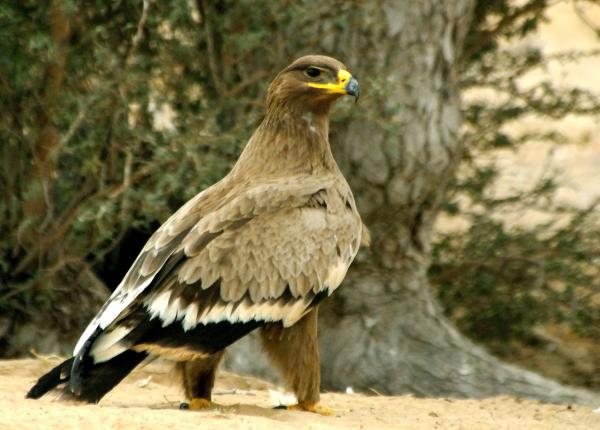Did You Know?
- There are two recognized subspecies of Steppe Eagle
- This eagle is known to nest near colonies of voles - one of their favorite prey items.
- In Mongolia, researchers discovered some Steppe Eagle nests that weren't constructed of sticks, but rather large mammal bones!
How The Peregrine Fund is Helping
Though The Peregrine Fund doesn't work directly with Steppe Eagles, in Kenya, our scientists are working hard to learn about and protect all raptors and their habitats. Through environmental education efforts, we are also working to put a stop to the common practice of poisoning carcasses to kill large predators, which also kills a host of wildlife including vultures, eagles, and other scavenging birds. These efforts will certainly benefit all raptors of the region, including the Steppe Eagle.
Meanwhile, our efforts in scientific research, habitat conservation, education, and community development help conserve birds of prey around the world. We also supply literature to researchers from our avian research library, which helps scientists around the world gather and share important information on raptor conservation. We also run the Global Raptor Impact Network which gives raptor researchers tools to more efficiently conduct their own studies while contributing to a global program. GRIN also provides citizen scientists a way to participate in raptor science and conservation.
Where They Live
The Steppe Eagle is found throughout parts of Europe, Asia, the Middle East, and Africa. It is found in a number of habitats including steppe, desert, semi-desert, open savanna, pastures, agricultural fields, paddy fields, grassland, and open woodland.
What They Do
This diurnal bird of prey has been known to rest, or roost on the ground, or in large groups in trees. Steppe Eagles are nearly always found in groups in winter, sometime numbering more than a hundred birds, and often in association with other raptors, especially Black Kites and Lesser Spotted Eagles.
The Steppe Eagle, like all top predators, plays a very important role in its environment. It hunts other animals for food but no animals hunt it on a regular basis. For most top predators, their only threat is humans. Top predators, such as the Steppe Eagle, play an important role in nature by helping to control populations of prey animals and maintain a balance in the ecosystems where they live.
The Steppe Eagle is also known as an umbrella species. Just as several people can stand under a large umbrella and be protected from the rain, so too can many species of wildlife be protected by conserving one species like the Steppe Eagle. To protect the eagles, we must protect the animals they need for food, the plants and animals that their prey feed on, and the trees that these eagles nest in, which helps protect the other animals that use these trees for food, shelter, and space. Conserving Steppe Eagles and their habitat automatically provides protection for all the other plants and animals that live there too.
Why They Need Our Help
The Steppe Eagle is categorized as an Endangered species, because of major declines in their populations over the past few decades. This is mainly due to the loss of their steppe habitat, which is being converted into agricultural fields. They also suffer from collisions with power lines and human persecution.
What They Eat
This eagle consumes a wide variety of prey including mammals, such as voles and ground squirrels, birds, such as Queleas, reptiles and insects, such as termites and locusts. They are even known to feed on carrion—the remains of already-dead animals. Steppe Eagles will hunt and catch prey directly on the ground, even waiting patiently at rodent burrows for their dinner to emerge! It has also been known to pirate (or steal) prey from other birds of prey!
Nests, Eggs, and Young
Steppe Eagles build relatively flat stick nests that they line with rags, feathers, and even dung. Historically, they constructed their nests directly on the ground, but more recently, they tend to nest higher off the ground on rock columns, in bushes and trees, on power poles, and even in old, abandoned cars!
The female lays 1-4 white eggs, usually with yellowish-brown markings. The eggs must be incubated for 45 days, at which time, nestlings covered in fluffy white down will hatch. The young eagles will grow quickly, and they will leave the nest when they are around 55–65 days.
References:
Global Raptor Information Network. 2021. Species account: Steppe Eagle Aquila nipalensis. Downloaded from http://www.globalraptors.org on 3 Dec. 2021
Meyburg, B.-U., P. F. D. Boesman, J. S. Marks, and C. J. Sharpe (2020). Steppe Eagle (Aquila nipalensis), version 1.0. In Birds of the World (J. del Hoyo, A. Elliott, J. Sargatal, D. A. Christie, and E. de Juana, Editors). Cornell Lab of Ornithology, Ithaca, NY, USA. https://doi.org/10.2173/bow.steeag1.01









